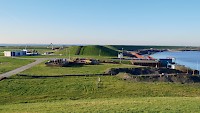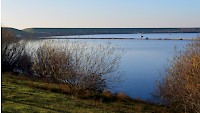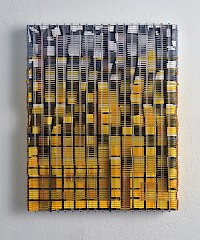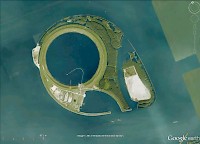IJsseloog – the IJssel-Eye – can be imagined as a mythical territory, an island with a hole, at the margins of the inhabited world. Infinitely deep, it obscures what civilization hides from itself. Paradisaical and serene, covered by plants and inhabited by wild animals and unaccessible to a common visitor, in its profundity the island houses the toxic debris that civilization cannot carry anymore. The man-made island lying in the middle of the tiny Ketelmeer in Holland, functions as a sort of black box of civilization's own self-destructive accumulations – a history that needs to be periodically encapsulated, in order to go on.
Nature is invented and it is this history of representations of nature, that fundament the critical human responses to it. The imaginary connected to the environment is an essential part of how the meaning of human experience is defined. A common topoi in the history of culture is that nature is envisioned as a singular, total and all encompassing presence, which is maybe due (paradoxically ) to the endlessly transmutable form of nature and its infinite hypostasis. IJsseloog means 'The Eye of the Ijssel River'. Although artificially projected and realized, it transports the hypnotic perfection of a wild vegetal and animal life, isolated from human presence. It is nevertheless a hybrid in which environment and extreme pollution, artificial and natural matter fuse.
Fiercely, the two British anthropologists Phil Macnaghten and John Urry, plead against what they call 'environmental realism', alleging that environment does not simply exist, that there is no singular nature - 'only a diversity of contested natures'- and there is no singular experience of it. Demonstrating the falseness of three assumptions that are taken for granted in cultural studies and in common perception, Macnaghten and Urry, elucidate the way 'each nature is constituted through a variety of socio-cultural processes from which it cannot be plausibly separated.'1 Firstly they argue against the assumption that the environment is essentially a 'real entity', which would be substantially separate from social practices and human experience. Secondly they contest the analysis of nature through identifying 'values' that it holds, values that people attribute to it and treated as consistent. Thirdly they contest the drawing of an indisputable human behavior towards it, that is considered sustainable.2
The manifold work of Robert Gschwantner is addressing the question how society sees and constructs itself and its own order, through appeal to its ideas of nature. His work explores the aesthetically and ethically ambiguous relation between man-made artificial, geometric landscapes and the idea of nature. Water is in his work omnipresent and vital and from it he extracts 'samples', like in a laboratory that is constitutive to his work.
In vast research projects, that imply geographical and geological research, scientific data collection, immersive exploration 'in situ' and the elaboration of a complex of works in various media and formats, Robert Gschwantner approaches the manifold dynamics between human intervention and destruction of nature and nature's own reaction, with its specific temporality and rhythm. Poisoned and polluted with chemical debris, or eroded in time, nature in Robert Gschwantner's work is nevertheless the carrier of a vast temporality, in which human and geological agency join evidences. His work is also describing the equivocal limit between nature and the agency of man – and contests a common opposition that imagines on one hand nature as a pure, intact territory, and on the other hand civilization that engulfs it with its contaminating toxicity.
The small IJsseloog Island is the object of a recent project of Robert Gschwantner, 'De IJsseloog Pupil'3, which explores the artificial island, which has been constructed between 1996-1999 in the Ketelmeer in the Netherlands in order to serve as a deposit for polluted heavy metals mud. The island with a perfect circular shape has at the center a hole, deeper than the surrounding sea. The polluted mud which set over time on the grounds of European rivers, contributed to the dying of their flora and fauna in the period between the 1950s and the 1990s. Pumped out from there, it has been transported by ships and isolated in the cavernous island of IJsseloog. The amount of poisonous waste that is stored on the island is of 23 million m³ and will still accommodate waste for the next 30 years, when it will be full and completely sealed off. Vegetation has been planted on the island around the highly toxic hole, deep inside the see and there is barely a visible 'proof' of its function as an artificial carrier of that which nature can actually not support more. If the project will run as planned, after sealing it, it will be transformed into an ecological resort island. But for now, the island is strictly closed to public access and only a few workers stay there.
Robert Gschwantner's 'De IJsseloog Pupil' project approaches the complexity of this phenomena in different media, that turn visible its various aspects. A video documents his own research trip on the island. The camera with wide planes accompanies his arrival by sea and his walks mapping the island's geography. Part of this project is also a collection of weavings of tubes (a media characteristic for his work) in which sample of the polluted mud is collected – relics which transport the reality of the island's formation. Thirdly, a model of the island expresses the architectonic dimension of the container, originated on the drawer board and literally placed within the sea.
The three types of media which Robert Gschwantner engages, come with their specific questions of temporality in the examination of IJsseloog. The video transmits the long duration of unconfined time which nature establishes. A model reproduces the immediacy of a technological hybrid turned functional in three years time. The formal aesthetic purity of the tube-works contains and transports the putrescent waste that contemporaneity leaves behind. The tubes retain the digestive malfunctions of the global economic structures and expose them in a broader social and political discourse.
'What interested me a lot was that animals have conquered their living territory on the island. While strolling on the island, I saw deers, foxes and sea eagles. The deers presumably reached the island one winter when they crossed the frozen sea and could not return. On the island there is also a forest, which was not planted there, but it was nature that conquered the land for itself. At dawn the deers come out from between these trees, where they hide during the day. Suddenly the island is full with deers. The animals seem not to be scared of humans here, I have watched also foxes during the day, which were only slightly surprised to see that someone was hindering there.”4
The presence of the animals on this island, as Robert Gschwantner recounts, is paradoxial, even enigmatic. It makes us think again on the power of nature that unequivocally and powerfully conquers with life, dead matter to itself. Animals can be understood as having a morphing agency that shapes history, although they do not leave behind many proofs and their presence (navigating by interior maps) can only be witnessed in rare moments and gains therefor a mythical aura.
Robert Gschwantner's project-based works (which usually consist of a video and tube- weavings) turn generally around architecture, artificial landscape and human intervention into landscape – and water. The Reflected Hexagon (Rome, Berlin, 2010), a video created with Giorgio Cappozzo, explores the shape of hexagon of two important transportation gates, that have been built in the past 2000 years: the ancient harbour of Portus near Rome (112 B.C., today forming the Lago di Traiano) and the Tegel Airport, built 1974 in Berlin. The fully operational modern airport, soon to be abandoned, is shown in dialogue with the Roman ruins now overtaken by nature, while the hexagon discovered by the Romans – the shape of a water crystal – endures as the perfect configuration for logistic purposes. Another project Land am strome (Kaprun, 2013), describes the hydro-electric power stations of Kaprun, Austria, set between terraced, artificial lakes. Up until the 1950's, the main complex merging nature and technology, was considered to be the largest man-made structure in the world. The project combines polaroids with the citations from the play Das Werk, by Austrian play writer Elfriede Jelinek, that describes its construction through forced labour during the Nazi regime. Another project, The Perfect Circle (Versailles, 2008, video created also with Giorgio Cappozzo), compares the topography of the 17th Century artificial garden and alleys complex at Versailles with the urban landscape of Lingang New City in China, a city of the future, dominated by a central water circle, whose completion is planned for the year 2020.
'What interests me in water is that it blocks that nature takes over the landscape. It is a typical phenomena that deltas are pushing the land towards the sea. The old port of Rome, an artificial lake, could not be taken back by the Tiber since it was filled with water and it is now integrated 3 km inside the land.”5 Therefor the main part of Robert Gschwantner's work is the collecting of what he calls relics – samples of liquids (often polluted, toxic ones) that he carefully stores in tubes, with a concrete, material frequency. Like building an archive for a future taxonomy, these specimens carry the consistency of a genuine, real historic evidence. Beside them, video infuses his project-based works with an expositive and narrative character: “Video is the most suitable medium to convey the experience of landscape. It can also count its history, it evidences the transformations that it goes through in time. It follows the formal perfection of these artificial landscapes, which are so reduced, so clear and quiet. Although French gardens are very geometric, 'IJsseloog' reminded me of the perfection of the English garden.”6
In this stratified geological data of which nature is formed, layers of civilization's collapsed built-matter are incorporated as history's detritus. Not only that nature is historically, geographically and socially constituted (as Macnaghten and Urry convince the reader) but as history disappears under the surface of the deep earth, with a set of species and relics, the contamination between nature and non-nature gets accelerated. IJsseloog Island is a form of effacing history by pushing it into the past forcefully: both in time (stopping and restoring the polluting process) and in space (burying it under the surface of the earth). Robert Gschwantner's work catches samples from this exceptional intervention into historic time.
Marta Jecu



